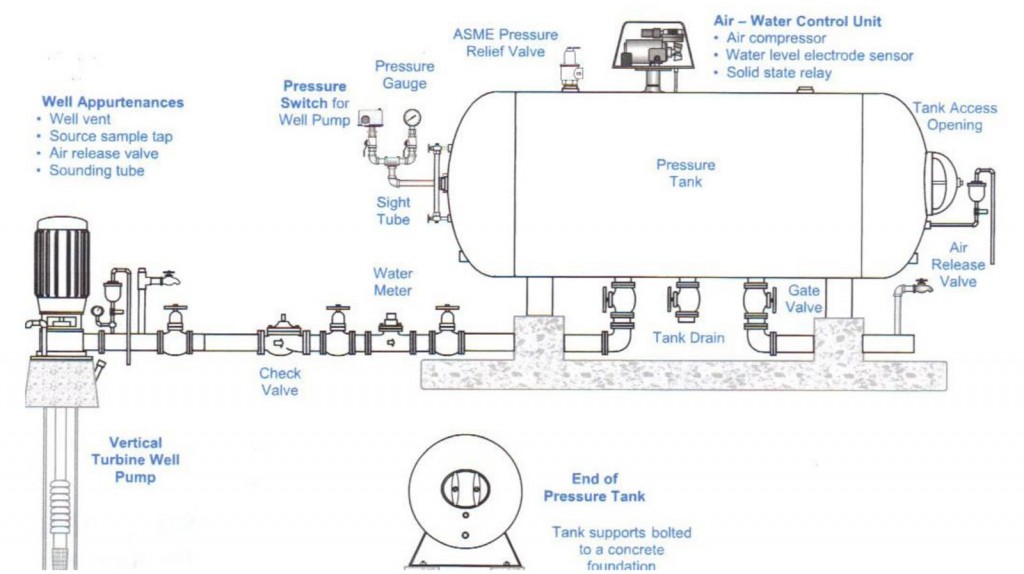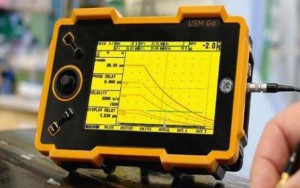 Global Engineering & Contracting, Inc. has a team of licensed professional inspectors experienced in inspection of hydropneumatic tanks at water treatment plants and other structures such as surge tanks, aeration basins & clarifiers, and wet wells at wastewater treatment plants.
Global Engineering & Contracting, Inc. has a team of licensed professional inspectors experienced in inspection of hydropneumatic tanks at water treatment plants and other structures such as surge tanks, aeration basins & clarifiers, and wet wells at wastewater treatment plants.
Global Engineering & Contracting, Inc. uses state of the art equipment like the “DMS Go Thickness Gage” by GE on the hydropneumatic tanks.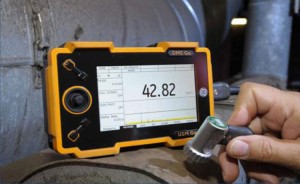
Water and wastewater systems are being alerted the hazards concerning aging hydropneumatic and surge tanks. The Association of California Water Agencies/Joint Powers Insurance Authority (ACWA/JPIA) recommends agencies take tank inspections seriously. Regular preventative maintenance, annual, and five-year inspections should be scheduled. Pressure vessels are dynamic devices. When they fail, they can fail catastrophically.
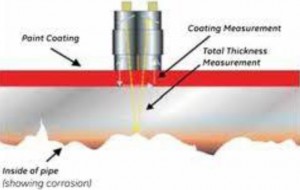 All metal vessels used as hydropneumatic or surge tanks must be constructed to American Society of Mechanical Engineers (ASME) standards or be Code-certified. This can often be verified by reviewing the manufacturer’s plate installed at the time of construction. Tanks without an ASME plate should be structurally evaluated by a registered engineer if the tank will continue to be pressurized.
All metal vessels used as hydropneumatic or surge tanks must be constructed to American Society of Mechanical Engineers (ASME) standards or be Code-certified. This can often be verified by reviewing the manufacturer’s plate installed at the time of construction. Tanks without an ASME plate should be structurally evaluated by a registered engineer if the tank will continue to be pressurized.
 The metal skin of pressure vessels is under continual tension. When corrosion, crack, or break occurs, it can rip through the metal skin at speeds in the range of hundreds of miles per hour. In other words, you won’t see it happening. You will hear it, and if you are standing next to it, you will not be able to move fast enough to get away from it.
The metal skin of pressure vessels is under continual tension. When corrosion, crack, or break occurs, it can rip through the metal skin at speeds in the range of hundreds of miles per hour. In other words, you won’t see it happening. You will hear it, and if you are standing next to it, you will not be able to move fast enough to get away from it.
 1. All tanks have a manufacturer’s plate indicating they were constructed to ASME standards
1. All tanks have a manufacturer’s plate indicating they were constructed to ASME standards
and lists the maximum operating pressure and minimum wall thickness.
2. A functioning pressure gauge is installed to monitor tank pressure.
3. Tanks have been cleaned and inspected within the past five years. IF NOT:
– An interior and exterior inspection is required to assess structural and coating integrity, pit, depth, and wall thickness.
– Individuals conducting these inspections should be experienced in American Society of Mechanical Engineers (ASME) standards, and be qualified as a National Board of Boiler and Pressure Vessel (NB) or American Petroleum Institute (API) inspector for determining regarding the structural and coating integrity of a finished-water storage tank.
– Water systems are advised to keep written records documenting these inspections.
– Tanks excluded from this recommendation would be HPDE and bladder tanks.
4. All pressure gauges, sight levels, and hoses are in working order, and free of damage or defects.
– A site level or other method for verifying the water level in a tank is required.
5. A pressure relief valve (PRV) is installed to prevent tank over-pressurization.
– The PRV installed must not exceed the maximum operating pressure of the tank.
– This valve should be tested and exercised periodically.
– PRVs should not be painted, tampered with, or damaged.
– PRVs should be replaced every five-years.
6. No visual signs of exterior damage or corrosion should exist.
– Tanks should be maintained and painted to prevent rust and corrosion.
– It is important to inspect the lower side and welding seams on tanks.
7. Tanks must be properly secured to a foundation to prevent accidental movement.
8. Any maintenance, repairs, grinding, sandblasting, or welding on hydropneumatic tanks should be performed by individuals properly trained, and certified to work on ASME pressure vessels.
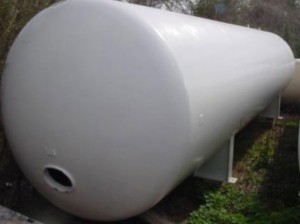 – Welds on tanks can only be made by a NB “R” stamp holder, and these repairs must be inspected by a NB inspector before the tank is pressurized and placed back into service.
– Welds on tanks can only be made by a NB “R” stamp holder, and these repairs must be inspected by a NB inspector before the tank is pressurized and placed back into service.
– Alterations to hydropneumatic tanks can reduce structural integrity and compromise the tanks pressure rating.
9. If a cut-in valve is installed between the tank and PRV, the valve must be isolated (locked open) to prevent it from being closed while the tank is operating under pressure until the cut-in valve can be removed.
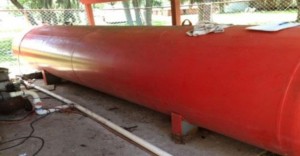 – The use or installation of a “cut-in valve” in front of the PRV is not recommended, or may not be allowed by Code.
– The use or installation of a “cut-in valve” in front of the PRV is not recommended, or may not be allowed by Code.
– The cut-in valve should only be closed by using lock out/tag out procedures, when the tank has been removed from operations.
10. As part of regular and annual preventive maintenance for conventional hydropneumatic and surge tanks, agencies are reminded to ensure: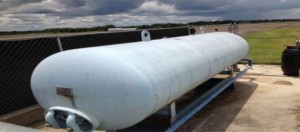
– The manufacturer’s plate indicating a tank was constructed to ASME standards is legible, and that it lists the maximum operating pressure.
– Tanks are secured to a foundation to prevent accidental movement.
– A functioning pressure gauge is installed to monitor the pressure.
– All pressure gauges, sight levels, and hoses are in working order and free of damage or defects.
– A pressure relief valve (PRV) is installed to prevent tank over pressurization.
– The PRV installed must not exceed the maximum operating pressure of the tank.
– The PRVs are tested and exercised periodically.
– PRVs are not painted, tampered with, or damaged.
– PRVs are replaced every five-years.
– If a cut-in valve is installed between the tank and PRV, the valve must be isolated (locked open) to prevent it from being closed while the tank is operating under pressure, until the cut-in valve can be removed.
– No visual signs of exterior damage or corrosion exist.
– Tanks are maintained and painted to prevent rust and corrosion. It is important to inspect the lower side and welding seams on tanks.
– An interior inspection is accomplished at least every five-years.
– If interior corrosion is found, an NB inspection is performed to determine the thickness of the vessel wall.
– If repairs are required, welds must only be completed by certified welders (NB “R” stamp holder).
– All repairs must be inspected by a NB inspector.
If an Agency is unsure of the condition of its hydropneumatic and surge tank or has not had their tanks inspected within the last five-years, the above inspections should be performed as soon as possible.
All metal vessels used as hydropneumatic or surge tanks must be constructed to American
Society of Mechanical Engineers (ASME) standards or be Code-certified. This can often be verified by reviewing the manufacturer’s plate installed at the time of construction.
Data found on the manufacturer’s plate is critical to evaluating the structural condition and operational levels for any hydro pneumatic or surge tank. ASME or Code Stamp, Serial Number, Shell and Head Thickness, Manufacturer’s Name, Maximum Allowable Working Pressure, and Year Constructed Construction Materials.
All metal vessels used as hydropneumatic or surge tanks must be constructed to American Society of Mechanical Engineers (ASME) standards or be Code-certified.
This can often be verified by reviewing the manufacturer’s plate installed at the time of construction. Tanks without an ASME plate should be structurally evaluated by a registered engineer if the tank will continue to be pressurized.
Hydropneumatic Tanks
There are several different functions that a hydropneumatic tank can perform. In a booster pump application, it can provide water to the system during periods of a no flow shutdown of the booster pump or it can provide water to replace leak loads. In a well water application, it can provide the desired volume of water required between the pump shut down pressure and the pump turn on pressure.
In a sprinkler or irrigation pump application, the tank may provide a cushion to maintain necessary pressure so the jockey pump will not short cycle. In any case, the amount of water that the tank will be required to supply to the system during any given cycle is called the drawdown. Drawdown must first be determined to properly size the hydropneumatic tank.
What are Hydropneumatic Tanks?
Hydropneumatic tanks are ASME and non-ASME vessels that hold water and air under pressure. In order to provide efficient water supply, hydropneumatic tanks regulate system pressures to quickly meet system demand. The compressed air creates a cushion that can absorb or apply pressure as needed. Air that is reabsorbed into the system water is sometimes replenished with the addition of a small air compressor. Large hydropneumatic tanks with volumes of 2,000 gallons or more are usually installed horizontally. Normal operating pressure is in the range of 60 to 75 psi, so most hydropneumatic tanks are rated to 100 psi.
A hydropneumatic tank contains pressurized air and water. It does not have a bladder and air is in direct contact with the water. The compressed air acts as a cushion exerting or absorbing pressure. This type of tank serves,
Three main functions:
1. Delivers water within a selected pressure range so the well pump is not continuously running.
2. Prevents a pump from starting up every time there is a minor call for water from the distribution system.
3. Minimizes pressure surges (water hammer).
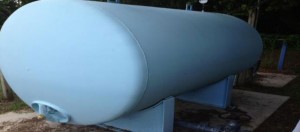 Well pumps and booster pumps work with pressure tanks to maintain a consistent pressure range in the system. The pressure tank maintains the pumping-cycle rate required to avoid overheating the pump motor and premature motor failure.
Well pumps and booster pumps work with pressure tanks to maintain a consistent pressure range in the system. The pressure tank maintains the pumping-cycle rate required to avoid overheating the pump motor and premature motor failure.
Hydropneumatic tanks work best with an air cushion of ¼ to ½ the tank capacity. This cushion decreases as water absorbs air and the tank loses its ability to pressurize the system. To keep that from happening, there must be an automatic way to replenish the air volume. Adding air manually is not the best way to ensure proper pressure-tank operation over time. (See page 2 for ways to add air.)
If a pressure tank becomes waterlogged, the motor cycles on and off too frequently (more than six times
an hour). This leads to:
• Higher energy costs. It takes a lot of electricity to get a pump motor started and operating at full speed.
• Inefficiency. The deeper the well, the longer it takes the pump to move water up and out into the system. A well pump may cycle so frequently that only a small amount of water reaches the distribution system before it turns off again.
• Equipment failure. Frequent starts and stops can overheat the pump and lead to premature motor failure.

